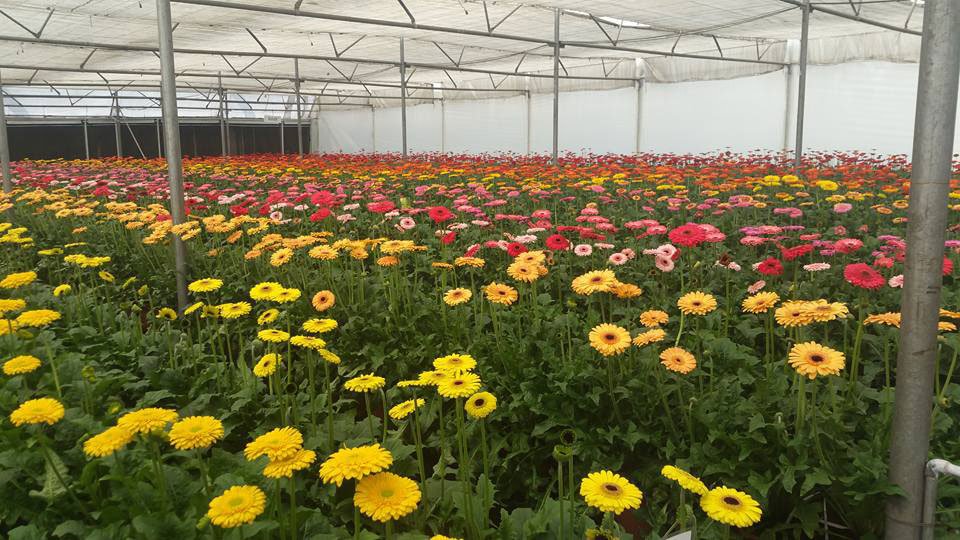Protected Cultivation Techniques of Gerbera
- Gerbera (Gerbera jamesonii) is a popular ornamental cut flower belonging to the family Asteraceae.
- It ranks among the top commercial flowers globally due to its bright colors, long vase life, and year-round demand.
- Protected cultivation ensures higher yield, quality blooms, and uniformity compared to open-field cultivation.
- Ideal for greenhouse, polyhouse, and net-house systems.

A. Importance of Protected Cultivation for Gerbera
- Ensures controlled growing conditions such as temperature, humidity, and light.
- Provides protection from heavy rainfall, high wind, and direct solar radiation.
- Reduces biotic stress caused by pests and diseases.
- Facilitates year-round production and export-quality flowers.
- Increases productivity (200–250 flowers/plant/year).
B. Climate and Environmental Requirements
- Temperature: Optimal day temperature 18–24°C; night temperature 12–14°C.
- Humidity: 70–75% relative humidity is ideal.
- Light: Requires 12–14 hours of light; shade nets (30–40%) may be used in summer.
- Ventilation: Natural or forced ventilation ensures optimum CO₂ concentration and air circulation.
C. Varieties
- Varieties for green house: Julia, Natasha, Alcatraz, Havana, Faith, Dakota, Grizzly, Basic.
- The high yielding varieties Sonata, Esmara, Opium, Solem, Gucci, Diana, Naome, Martinque, and Maidemoselli were useful for obtaining higher returns under naturally ventilated polyhouses
D. Propagation and Planting
- Propagated mainly through tissue culture plantlets or division of suckers.
- Plantlets are virus-indexed, healthy, and uniform in growth.
- Planting time: Best during February–March and September–October in Nepal.
- Spacing: 30 × 30 cm; about 8–10 plants per m².
- Bed preparation: Raised beds (1 m width, 20–30 cm height) with well-drained media.
E. Growing Media
- Well-drained, porous, and sterile growing media is essential.
- Common mixture: Cocopeat + Perlite + Vermicompost (3:1:1).
- pH: 5.5–6.5; EC: < 1.0 dS/m.
- Soil solarization or fumigation is essential before planting.
F. Nutrient and Irrigation Management
- Gerbera requires balanced nutrition under fertigation.
- Macronutrients: NPK in 3:1:4 ratio; Ca, Mg, S supplementation needed.
- Micronutrients: Fe, Zn, Mn, Cu, B applied through foliar sprays or fertigation.
- Irrigation: Drip irrigation preferred; 2–3 irrigations per week depending on season.
- Maintain optimum soil moisture (field capacity).
G. Crop Management Practices
- Mulching: Black polythene or organic mulch to reduce weed growth and conserve moisture.
- Disbudding: Removal of side buds to improve flower quality.
- De-leafing: Removal of diseased, damaged, or old leaves for better aeration.
- Staking: Not required in gerbera, but flowers must be harvested carefully to avoid bending.
Use of PGRs:
- GA₃ (50–100 ppm) promotes flower stalk elongation.
- CCC (Cycocel, 250 ppm) reduces excessive vegetative growth.
H. Pest and Disease Management
Major Pests:
- Aphids, whiteflies, thrips, leaf miners, mites.
- Control: Yellow/blue sticky traps, neem oil sprays, systemic insecticides.
Major Diseases:
- Powdery mildew, botrytis blight, fusarium wilt, root rot.
- Control: Proper ventilation, fungicide sprays, use of disease-free planting material.
- IPM practices: Use of biological control agents (Trichoderma, Pseudomonas, predatory mites).
I. Harvesting and Post-Harvest Management
- Harvest at half to two-thirds open stage when outer 2–3 whorls are perpendicular to the stalk.
- Harvesting method: Twist and pull the stem from the base to avoid rotting.
- Grading: Based on stalk length, flower diameter, and freshness.
- Vase life: 7–14 days with preservative solution (Sucrose + Germicide).
- Storage: 2–4°C for 2–3 weeks under 90% relative humidity.
J. Yield
- Average yield: 200–250 flowers/plant/year under greenhouse conditions.
- Commercial productivity: 150,000–200,000 flowers/ha/year.
K. Economic Importance
- High return on investment due to year-round demand.
- Export potential in European and Middle Eastern markets.
- Significant employment generation in floriculture industry.